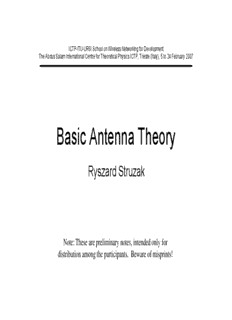
Basic Antenna Theory - Wireless - ICTP PDF
Preview Basic Antenna Theory - Wireless - ICTP
ICTP-ITU-URSI School on Wireless Networking for Development The Abdus Salam International Centre for Theoretical Physics ICTP, Trieste (Italy), 5 to 24 February 2007 Basic Antenna Theory Ryszard Struzak Note: These are preliminary notes, intended only for distribution among the participants. Beware of misprints! Purpose • to refresh basic physical concepts needed to understand better the operation and design of microwave antennas R Struzak 2 Outline • Introduction • Review of basic antenna types • Radiation pattern, gain, polarization • Equivalent circuit & radiation efficiency • Smart antennas • Some theory • Summary R Struzak 3 Quiz Transmitting antennas used to radiate RF energy, whereas receiving antennas designed to capture RF energy Somebody told that receiving antennas, radiate radio waves during the reception Is it a true fact or a slip of the tongue? R Struzak 4 • It is true... R Struzak 5 Intended & unintended radiators • Intended antennas – To produce/ receive specified EM waves: • Radiocommunication antennas; • Measuring antennas; • EM sensors, probes; • EM applicators (Industrial, Medical, Scientific) R Struzak 6 • Unintended antennas - active – EM waves radiated as an unintended side- effect: • Any conductor/ installation with varying electrical current (e.g. electrical installation of vehicles) • Any slot/ opening in the screen of a device/ cable carrying RF current R Struzak 7 • Unintended antennas - passive • Any discontinuity in transmission medium (e.g. conducting structures/ installations) irradiated by EM waves – Stationary (e.g. antenna masts or power line wires); – Time-varying (e.g. windmill or helicopter propellers); – Transient (e.g. aeroplanes, missiles) R Struzak 8 Antenna function • Transformation of a guided EM wave (in waveguide/ transmission Space wave line ) into an EM wave freely propagating in space (or vice versa) – Transformation from time-function into RF wave (= vectorial field dependent on time and 3 space-dimensions) – The specific form and direction of the wave is defined by the antenna structure and the environment Guided wave R Struzak 9 • Transmission line – Power transport medium – the transition ideally without power reflections (matching devices!) • Radiator – Must radiate efficiently – must be of a size comparable with the half-wavelength • Resonator – Unavoidable - for broadband applications resonances must be attenuated R Struzak 10
Description: